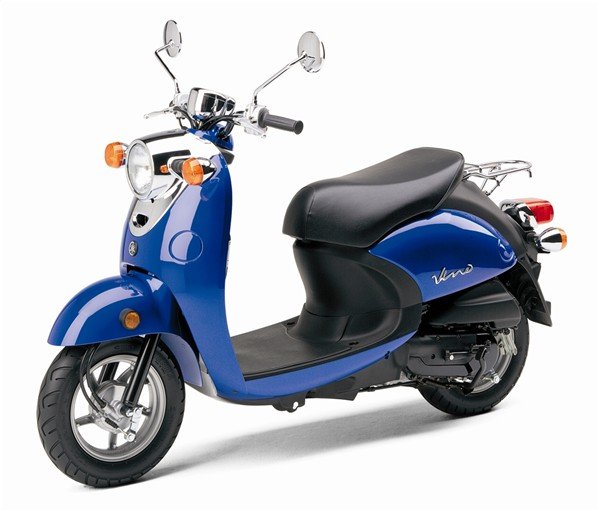YAMAHA VINO & VINO CLASSIC (YJ50, XC50)
With Vespa’s successful return to the North American market in 1999, the market for vintage styled scooters was ignited. Yamaha responded for 2002 with their all new 50cc Vino (model code YJ50).
This first generation of Vino used a peppy 2-stroke motor and was sold from 2002 – 2005. For 2006 Yamaha freshened up the Vino with a fuel sipping 4-stroke engine and a bunch of smaller style tweaks. This second generation used the model code XC50 and remained on sale until 2018.
Yamaha also sold a larger Vino 125 version of this scooter which is discussed separately.
 YJ50 Generation: 2002 – 2005
YJ50 Generation: 2002 – 2005
The first iteration of the Vino to hit the USA and Canada was the YJ50 model. Yamaha introduced this scooter for 2002 and it was sold through 2005. This scooter was sold as simply the ‘Vino’, while second generation examples were commonly called the ‘Vino Classic’.
This first generation of Vino was the more speedy one, due to the powerful 2-stroke Minarelli engine. This motor was simple (ie. air cooling, carbureted) but powerful and reliable. The Minarelli engine is a proven design that first got it start with Yamaha’s Jog in the 80’s but it’s been updated many times since then.
Larger riders and performance enthusiasts will find these early Vino’s more desirable than the 4-stroke Vino’s to come. The downside to this powerful engine is the lower milage (65-70mpg), shorter engine life and higher emissions that are part of the trade off with 2-stroke engines. For more discussion on 2-stroke vs. 4-stroke engines have a read here.
The style of these early Vino’s looks very similar to the 4-stroke Vino’s to come, but there were a number of small changes which are detailed in the XC50 section. The YJ50 Vino was unchanged over its four year run.
XC50 Generation: 2006 – 2011, 2013 – 2018
After 4 successful years, Yamaha decided that an update was in order to freshen the styling and to meet new emissions regulations. This was around the same time Yamaha had to pull the Zuma off the market for a couple years while they worked on lowering its 2-stroke emissions. The result of this overhaul was a refined look (above), a longer name (Vino Classic) and a modern fuel sipping 4-stroke engine. Some literature refers to this scooter as simply the ‘Vino’ or ‘Vino 50’, but often press material from Yamaha calls it the ‘Vino Classic’.
The 2006 update to the Vino ended up being a pretty major overhaul despite the visually subtle changes to the styling. This overhaul came with a new model code (XC50) to replace the old one (YJ50). Yamaha uses these codes internally to refer to their scooters and they’re helpful to owners looking for manuals or parts as they are a clear way to identify scooters which are often sold under a host of names internationally. The service manuals for both generations can be downloaded here and they offer a slew of info and photos for anyone working on their Vino.
Style wise, Yamaha made a long but subtle list of changes to create the XC50 generation. On the front half of the scooter, new telescopic forks replaced the older leading link design and five spoke rims replaced the older 3 spoke design (which were actually lifted from the CY50 Jog). Elsewhere, Yamaha redesigned the Vino logo, reshaped the seat, simplified the floorboard and mildly reshaped the back end. The general shape and headlight array were left intact, but once you dig a little deeper there are lot of small changes to be found.
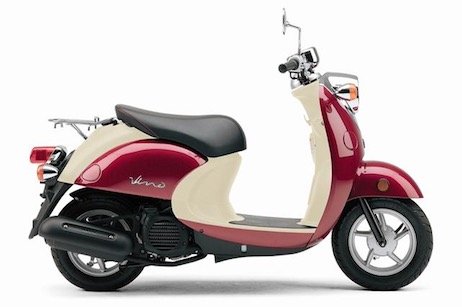
In the engine bay, Yamaha replaced the trusty but dated 2-stroke power plant with a modern 3-valve, liquid cooled, 4-stroke engine. The 2-stroke engine found in the previous generation Vino’s was a good performer, but it suffered from the typical 2-stroke problems: smell, sound, pollution, fuel economy and reliability. The new 4-stroke engine didn’t make quite as much power as the 2-stroke but the new engine still performs nicely and it offers a host of advantages like significantly improved milage, a longer engine life, lower emissions and no smoke or smell.
This new engine would also be used in the 2007-2011 C3. but the C3 went a step further and got fuel injection as well. The new Vino continued to use a carb until fuel injection was finally announced for 2013.
The top speed with this new engine remained around 40-43mph but it does take a bit longer to get there than the 2-stroke. 4-stroke 50cc engine’s aren’t restricted in their stock form like 2-stroke motors are because they need every drop of power to make the scooter accelerate acceptably. Accordingly, if you have dreams of modifying a Vino 50 for higher speeds it is best to start with a YJ50 model.
Design and Amenities
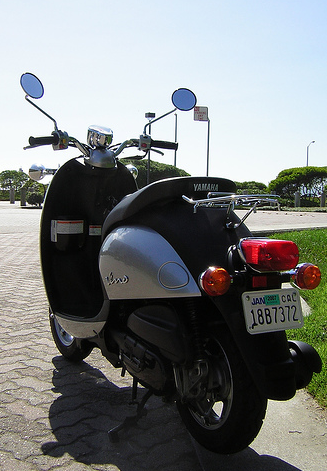
Discussion
If you’re interested in the Vino, you may be dreaming of owning a Vespa but don’t want to shell out the extra grand for the Vespa name. In Vespa’s defence, you do get some nice features that warrant some of the extra cost (like a front disc brake, metal body, glovebox and a computer chip anti-theft device in the key) but yes, you are paying some for the name. With a MSRP of $2299 (2017), the Vino (and Honda’s Metropolitan) are aimed at the people who would prefer not to shell out $3000+ for a 50cc scooter. Both of these scooters offer vintage styling at a lower price. If you’re looking for reliable retro styled transportation, any of these scooters will do nicely. If you’re dreaming of a Vespa though, spend the extra to get what you really want because they do hold their value well.
In a lot of ways the Vino is like the many other retro scooters in its class. It’s got a nice storage space under the seat for a full face helmet, okay brakes, good quality, nice milage (great milage for the updated 4-stroke version) and shiny chrome bits. Other good scooters that share these traits are Vespa’s ET50 and LX50, Kymco’s Like and Sento models and Honda’s Metropolitan / Jazz. Have a look at all these scooters and decide based on looks, price and whether you want a 2-stroke or 4-stroke engine. There’s also a few other Taiwan built scooters like Genuine’s Buddy, PGO’s Metro, SYM’s Mio 50 and TNG’s Venice that offer a lot of value and quite respectable reliability as well.
The primary thing that set the Vino 50 4-stroke apart is its high tech engine – it’s the best engine in this class. The XC50 motor (also found in the C3 and 2012 Zuma 50F) was the first 4-stroke 50cc scooter engine in North America with fuel injection and 3-valves. With a Taiwan built scooter you’re getting an older mass produced 2-stroke engine, which means it’s powerful and reliable, but fuel economy and engine refinement aren’t quite as good.
Pros:
- Reliable (all years)
- Great high tech 4-stroke engine (2006 – present)
- Affordable
Cons:
- Drum brakes front and rear
- No glovebox
Links:
YJ50 (2001 – 2005) Vino Service Manual – Essential for working on your own scooter.
XC50 (2006 – 2010) Vino Service Manual – Very helpful for anyone who works on their own scooter
MotorscooterGuide Forums – Visit the forum on this site to chat about this scoot.
2-Stroke Vino (YJ50) Key Specs:
- Engine: 49cc air-cooled 2-stroke single
- Bore x Stroke: 40.0mm x 39.2mm
- Compression Ratio: 7.3:1
- Carb: 14mm Teikei Carb
- Ignition: CDI
- Transmission: V-belt automatic
- Final Drive: V-belt
- Front Suspension: Bottom link fork, 1.57-in travel
- Rear Suspension: Single shock, 1.77-in travel
- Brakes: 110mm drum (front and rear)
- Tires: 80/90-10 (front and rear)
- Length: 64.1 in
- Width: 24.8 in
- Height: 40.5 in
- Seat Height: 28.1 in
- Wheelbase: 45.3 in
- Ground Clearance: 3.3 in
- Fuel Capacity: 1.6 gal (6L)
- Dry Weight: 163 lbs
4-Stroke Vino (XC50) Key Specs:
- Engine: 49cc liquid-/air-cooled 4-stroke single, SOHC, 3 valve
- Bore x Stroke: 38.0mm x 43.5mm
- Compression Ratio: 12.0:1
- Fuel: 14mm Teikei Carb (’06-’11), Fuel Injection with 19mm Mikuni throttle body (2013-present)
- Ignition: CDI
- Transmission: V-belt automatic
- Final Drive: V-belt
- Front Suspension: Telescopic fork, 2.3-in travel
- Rear Suspension: Single shock, 2.1-in travel
- Brakes: 110mm drum (front and rear)
- Tires: 90/90-10 (front and rear)
- Length: 65.6 in
- Width: 24.8 in
- Height: 39.6 in
- Seat Height: 28.1 in
- Wheelbase: 45.7 in
- Ground Clearance: 3.3 in
- Fuel Capacity: 1.2 gal (4.5L)
- Weight: 166 lbs (Dry), 179 lbs (Wet)
- MSRP: $2299 (USA), $2899 (Canada) for 2017
Colors:
- 2001: Wine, Black
- 2002: Very Dark Blue Cocktail, Dull Red Metallic
- 2003: Very Dark Blue Cocktail, Dull Red Metallic
- 2004: Pale Purplish Blue Metallic, Black Metallic
- 2005: Pale Purplish Blue Metallic, Black Metallic
- 2006: Black Metallic, Silver 3, Dull Red Metallic
- 2007: Black Metallic, Deep Purplish Blue
- 2008: Black Metallic, Deep Purplish Blue
- 2009: Indigo Blue, Alpine White
- 2010: Raspberry Metallic
- 2011: Seashell aka Metallic Yellowish Gray (brown trim)
- 2013: Vanilla White (aka Yellow-ish Gray in Canada)
- 2014: Deep Sea Blue (called Dark Metallic Grayish Blue in Canada) – Really tan with blue and red accents.
- 2015: Spartan Red
- 2016: Rosewood Brown (aka Dark Metallic Reddish Gray in Canada)
- 2017: Two tone Deep Sea Blue/Vanilla White (Dark Metallic Grayish Blue in Canada)
- 2018: Two tone Deep Sea Blue/Vanilla White (Dark Metallic Grayish Blue in Canada)

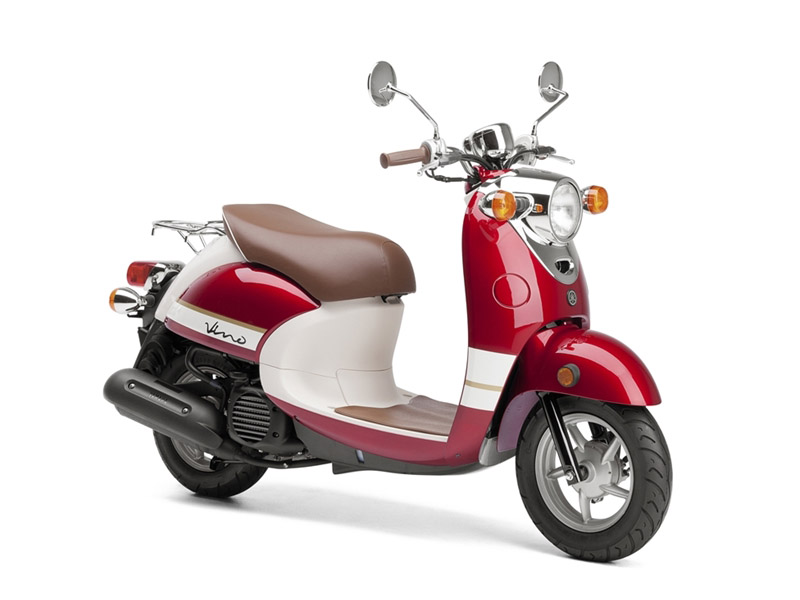
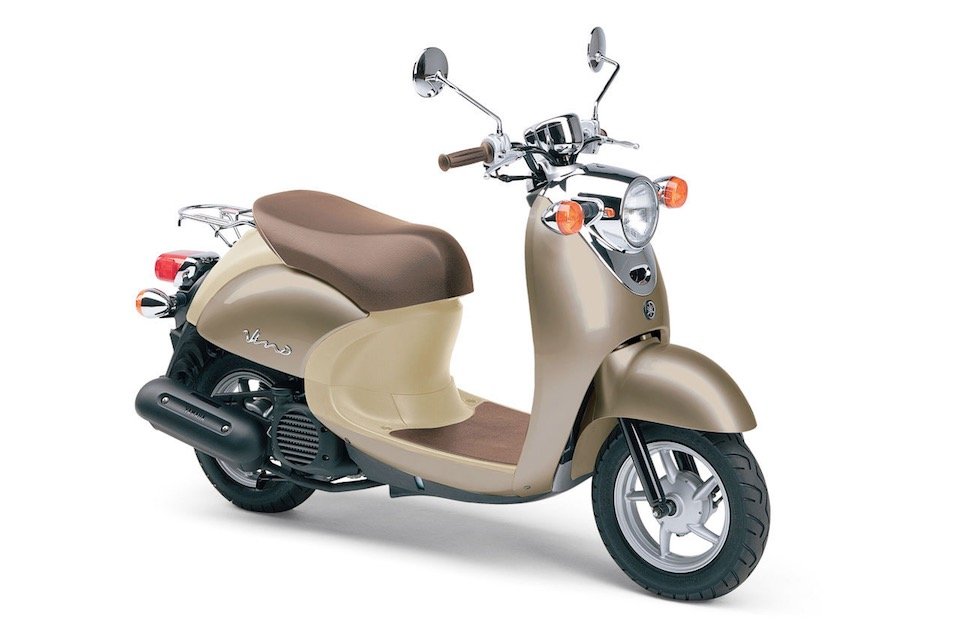
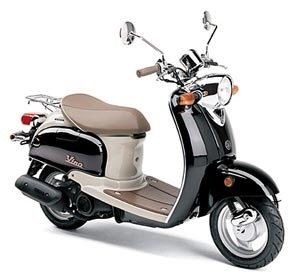 YJ50 Generation: 2002 – 2005
YJ50 Generation: 2002 – 2005